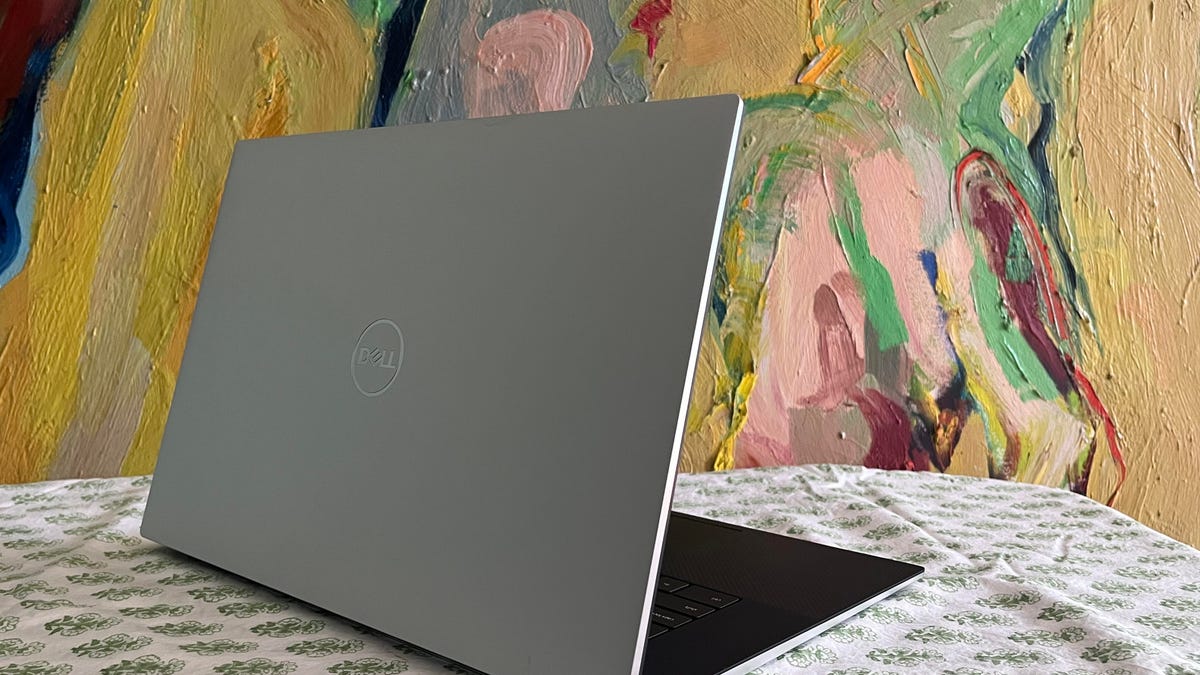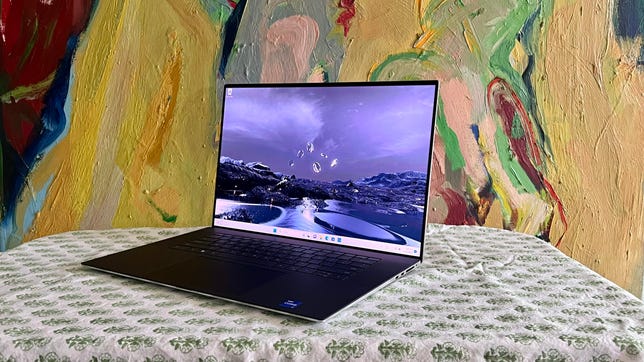

8.0
Dell XPS 17 9730
Like
Huge 17-inch 16:10 display
Attractive, rigid design
Strong graphics performance
Long battery life
Don’t like
No OLED option
Grainy, outdated low-res webcam
Heavy at nearly 5.5 pounds
In many ways, the Dell XPS 17 9730 is the opposite of the LG Gram 17 I reviewed last month. Both the XPS 17 and Gram 17 are geared toward content creators looking for an RTX-powered, large-screen laptop, but the similarities stop there. The XPS 17 features the same size screen as the Gram 17 — a mammoth 17-inch, 16:10 panel — but it’s wrapped in a rigid aluminum chassis that’s more than two pounds heavier than the magnesium-alloy Gram 17. Unless you plan to create and edit content in a different location each day, the XPS 17 9730 is the better choice. It’s sturdier, faster and longer-running.
The XPS 17 9730 gets its performance edge over the Gram 17 from using a higher-powered Core i7 H-series processor to the Gram 17’s Core i7 P-series chip. It features an RTX 4070 discrete GPU that’s more powerful than the Gram 17’s older RTX 3050 GPU. Plus, its 4K, 500-nit display is crisper and brighter than the Gram 17’s. Our biggest gripes are the lack of an OLED display option and Dell trotting out a 720p webcam, which was outdated when we saw it on last year’s model. If you’re willing to sacrifice an inch of screen space, the Samsung Galaxy Book 3 Ultra remains our recommendation for content creators, whether you own other Galaxy devices or not.
Configuration as tested
| Price as reviewed | $3,399 |
|---|---|
| Display size/resolution | 17-inch 3,840×2,400 touch LCD |
| CPU | 2.4GHz Intel Core i7-13700H |
| Memory | 32GB DDR5 4,800MHz |
| Graphics | 16GB Nvidia GeForce RTX 4070 |
| Storage | 1TB NVMe PC801 NVMe SK Hynix |
| Networking | Wi-Fi 6 1675 (AX211), 2×2, 802.11ax, Bluetooth 5.3 |
| Operating system | Windows 11 Home 22H2 |
In typical Dell fashion, the XPS 17 9730 offers a limited number of customization options. The baseline model costs $2,449 and features a Core i7-13700H CPU, 16GB of RAM, GeForce RTX 4050 graphics, a 512GB SSD and a 17-inch display with 1,920×1,200-pixel resolution. Our $3,399 test system features upgrades on everything but the CPU, doubling the RAM to 32GB, the SSD to 1TB and the display resolution to 3,840×2,400 while also bumping up the GPU to an RTX 4070. You can also opt to upgrade the CPU to a Core i9-13900H and the graphics to an RTX 4080. The XPS 17 9730 is available in the UK starting at £2,248.99 and in Australia starting at AU$3,998.50.
The XPS 17 9730 got off to a bit of a slow start in labs testing, finishing behind last year’s model on our Geekbench 5 and Cinebench tests, which indicates that the Core i7-13700H CPU isn’t much of an upgrade over the Core i7-12700H chip. On our graphics tests, the XPS 17 9730 moved ahead of the previous XPS 17 9720 and by healthy margins, showing the added oomph you get with moving from an RTX 3050 GPU to an RTX 4070. The XPS 17 9730 shone on our 3DMark test and posted strong frame rates on the games Guardians of the Galaxy and The Riftbreaker, two of the gaming tests we ran on it. And despite a high-octane Core i7-13700H CPU and midrange RTX 4070 graphics powering a huge 4K display, the XPS 17 9730 delivers outstanding battery life, lasting nearly 12 hours on our demanding online streaming battery drain test.
Same on the outside, new on the inside
This year’s XPS 17 features the same chassis as previous iterations: sleek, sturdy and somewhat hefty. It tips the scales at 5.4 pounds, which is substantially heavier than the 3.2-pound Gram 17. And while its 17-inch display is slightly larger than that of the 16-inch MacBook Pro, Apple’s largest MacBook is considerably lighter at 4.7 pounds. The XPS 17 certainly has some heft to it, but it’s not bulky, measuring just 0.8 inches thick. That’s only a hair thicker than the exceptionally thin and light 0.7-inch Gram 17 and the even thinner 0.7-inch MacBook Pro 16.
When closed, the XPS 17 is a sea of brushed aluminum and looks similar to the MacBook Pro but with corners that are less rounded and more square. The silver aluminum doesn’t extend to the keyboard deck. That’s made from carbon fiber and has a fine, almost houndstooth pattern running across it. I like the two-tone look and the feel of the soft, rubberized finish of the carbon-fiber finish on the wrist rest below my palms as I type.
The aluminum lid and carbon-fiber keyboard deck offer a sturdy, rigid feel with no worrisome flex. The XPS 17 is a solid-feeling laptop. The keyboard felt immediately comfortable and roomy, in large part because Dell omits a number pad despite having the room to cram one on this large laptop. Excel jockeys and other number crunchers may bemoan its absence, but I don’t and prefer to have the keyboard centered below the display. I also liked the huge touchpad and its soft and quiet click response.
Without a numpad, there’s room for two large speaker grills on either side of the keyboard for the upward-firing quad speakers. The XPS 17 has two 1.5-watt tweeters and two 2.5-inch woofers that deliver surprisingly rich and full sound. You won’t need headphones for watching shows and movies; dialog is clear, and sound effects are realistic. I even detected a hint of bass with music playback and thought the speakers sufficed for listening to Spotify or music on YouTube while I worked. The sound was enough to fill my small home office.
Our XPS 17 test system features the upgraded display option that adds $300 to the bill and doubles the resolution to 3,840×2,400 pixels. The image is crisp and bright, and yet I’m left feeling underwhelmed. With its upgrades, our test system costs $3,399, and content creation laptops that cost that much ought to have an OLED panel. If I were a creative professional, I’d rather work on the slightly smaller (16 inch) and lower resolution (2,880×1,800) AMOLED display of the Samsung Galaxy Book 3 Ultra for its stellar color accuracy and contrast and faster 120Hz refresh rate. The XPS 17’s panel runs at a standard 60Hz, which might disappoint not only gamers looking to make use of the RTX 4070 graphics but also video editors looking for smoother movement than 60Hz can provide.
It’s starting to get a bit ridiculous with the 720p webcam. It was outdated on last year’s model, and even more so on the XPS 17 9730. Most mainstream laptops have moved to 1080p cameras by now, so the high-end XPS 17 9730 is severely behind the times. To your Zoom videoconference mates, you’ll appear grainy, with overly red skin tones.
The XPS 17 offers four USB-C ports with Thunderbolt 4 support and includes an adapter in the box for USB-A and HDMI connectivity. I don’t like needing to carry around an adapter, but I do like getting a quartet of Thunderbolt 4 connections. There’s also a combo audio jack and a full-size SD card slot, which is always appreciated on a laptop geared toward content creation.
At its cost of $3,399, the Dell XPS 17 9730 is too pricey not to at least offer an OLED display. And it’s about two years late (and counting) to the 1080p webcam party. Those complaints aside, the XPS 17 9730 boasts a sturdy yet thin design and proved to be a strong graphics performer. Dell often discounts the XPS 17 9730 along with the rest of its laptops, and I’ve seen the price of our test system configuration drop as low as $2,649. At this price, the lack of an OLED option is more forgivable. The low-res webcam, however, is not.
The review process for laptops, desktops, tablets and other computer-like devices consists of two parts: performance testing under controlled conditions in the CNET Labs and extensive hands-on use by our expert reviewers. This includes evaluating a device’s aesthetics, ergonomics and features. A final review verdict is a combination of both objective and subjective judgments.
The list of benchmarking software we use changes over time as the devices we test evolve. The most important core tests we’re currently running on every compatible computer include: Primate Labs Geekbench 5, Cinebench R23, PCMark 10 and 3DMark Fire Strike Ultra.
A more detailed description of each benchmark and how we use it can be found on our How We Test Computers page.
Geekbench 5 (multicore)
MacBook Pro (16-inch, 2023) 15009Dell XPS 17 9720 13241Samsung Galaxy Book 3 Ultra 12558Dell XPS 15 9530 12375Dell XPS 17 9730 12355LG Gram 17 Pro 9983
Cinebench R23 (multicore)
Dell XPS 17 9720 16152Samsung Galaxy Book 3 Ultra 15965Dell XPS 15 9530 15776MacBook Pro (16-inch, 2023) 14803Dell XPS 17 9730 13948LG Gram 17 Pro 10062
3DMark Wild Life Extreme Unlimited
Dell XPS 17 9730 17740Dell XPS 15 9530 14554MacBook Pro (16-inch, 2023) 12989Samsung Galaxy Book 3 Ultra 12853Dell XPS 17 9720 12615LG Gram 17 Pro 3663
Guardians of the Galaxy (High @1920 x 1080)
Dell XPS 15 9530 136Samsung Galaxy Book 3 Ultra 131Dell XPS 17 9730 122Dell XPS 17 9720 87LG Gram 17 Pro 60
The Riftbreaker GPU (1920 x 1080)
Dell XPS 17 9730 236Samsung Galaxy Book 3 Ultra 223Dell XPS 15 9530 199Dell XPS 17 9720 159LG Gram 17 Pro 94
Online streaming battery drain test
MacBook Pro (16-inch, 2023) 1474Dell XPS 17 9730 714LG Gram 17 Pro 664Samsung Galaxy Book 3 Ultra 634Dell XPS 15 9530 604Dell XPS 17 9720 599
System configurations
| Dell XPS 17 9730 | Microsoft Windows 11 Home; 2.4GHz Intel Core i7-13700H; 32GB DDR5 4,800MHz RAM; 16GB Nvidia GeForce RTX 4070 graphics; 1TB SSD |
|---|---|
| Dell XPS 17 9720 | Microsoft WIndows 11 Home; 2.3GHz Intel Core i7-12700H; 32GB DDR5 4,800MHz RAM; 6GB Nvidia GeForce RTX 3060 Graphics; 1TB SSD |
| Dell XPS 15 9530 | Microsoft Windows 11 Home; 2.4GHz Intel Core i7-13700H; 32GB DDR5 4,800MHz RAM; 8GB Nvidia GeForce RTX 4070 graphics; 1TB SSD |
| Samsung Galaxy Book 3 Ultra | Microsoft Windows 11 Home; 2.4GHz Intel Core i7-13700H; 16GB DDR5 6,000MHz RAM; 6GB Nvidia GeForce RTX 4050 graphics; 1TB SSD |
| LG Gram 17 Pro | Microsoft Windows 11 Home; 2.2GHz Intel Core i7-1350P; 32GB DDR5 6,000MHz RAM; 4GB Nvidia GeForce RTX 3050 graphics; (2) 1TB SSD |
| MacBook Pro (16-inch, 2023) | Apple MacOS Ventura 13.2; Apple M2 Pro (12 CPU cores, 19 GPU cores); 32GB LPDDR5 RAM; 1TB SSD |
